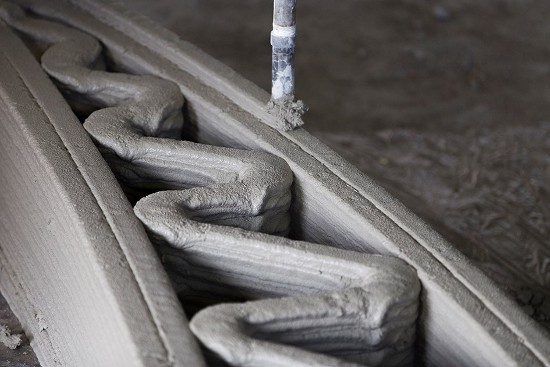A British first is about to be launched in the building of a new rail line in the United Kingdom. The technology they describe as printfrastructure is using a 5-ton computer-operated mobile robot that prints concrete containing reinforced microscopic strands of graphene. No steel rebar is needed during the construction and carbon footprints during builds are reduced by almost 50%.
The project is a high-speed rail system, called HS2, and will cost an estimated $147 billion US. The contractor is Skanska Costain Strabag, a joint venture between a Swedish and British company. The rail system will be 530 kilometres (330 miles) in length with the first phase due for completion from London to Birmingham by 2026.
Printfrastructure refers to a process of building infrastructure using on-site robot 3D-concrete printers. There are no prefabricated parts to ship and assemble, and no mixing and pouring of concrete foundations into forms and frames. The robot printer can work in a variety of settings including physically restrictive spaces without a human present. The print pattern is a lattice (see image above) which means much less concrete is needed during the build without sacrificing strength. The robot printers can operate without disrupting existing railway travel and other surrounding activities, so trains and commutes will be uninterrupted during construction.
The concrete materials breakthrough is the incorporation of microscopic strands of graphene, each just several atoms thick. Versarien, an advanced materials company is the inventor of the concrete with graphene which replaces the steel rebar that today is featured on most construction sites. The added graphene produces nearly invisible fine striping in the concrete as it is printed. And better yet, the graphene strengthens the concrete to make it resistant to corrosion whether exposed to air or water.
Imagine being able to print infrastructure and buildings no longer requiring steel rebar, often a material weakness as concrete buildings age and as was recently noted when an ageing Flordia condominium building collapsed north of Miamia costing the lives of more than 100 residents. After the building collapse, I investigated the material properties of reinforced concrete with rebar. This combination of two materials, cement and steel rods, produces an electrochemical process if exposed to air or water leading to corrosion as the building ages. Called carbonation, the rate of corrosion can be as much as one millimetre (0.04 inches) per year. In the UK where it rains a lot, carbonation corrosion rates will be as fast or faster than those in Florida.
That problem goes away if graphene-laced reinforced concrete is used instead of concrete with steel rebar. The commercial use is not limited to railway lines. You can imagine it becoming the material of choice for any projects where water is involved such as wastewater and freshwater infrastructure. And for homes, apartments, and commercial buildings it could extend the lives of these properties while reducing maintenance costs.
The use of 3D printers in building construction is not new. Dubai recently committed to using 3D printers in all new building construction. And in the latest issue of The Economist, it describes two California-based companies, Palari Homes and Mighty Buildings and a project to construct homes using 3D-printed concrete materials. The printing is done in a factory with no supporting moulds. Eaves, ceilings, and walls are then delivered to the building site where they get attached to a 3D-printed foundation. The process the companies are using is largely automated leading to dramatic savings in labour, and a doubling in the speed of production. Building homes this way produces 2 fewer tons of carbon emissions. And the emissions saved by Palari Homes and Mighty Buildings could even be more if, in future, they were to switch to graphene-reinforced concrete, the material HS2 is using for its new high-speed rail project.









